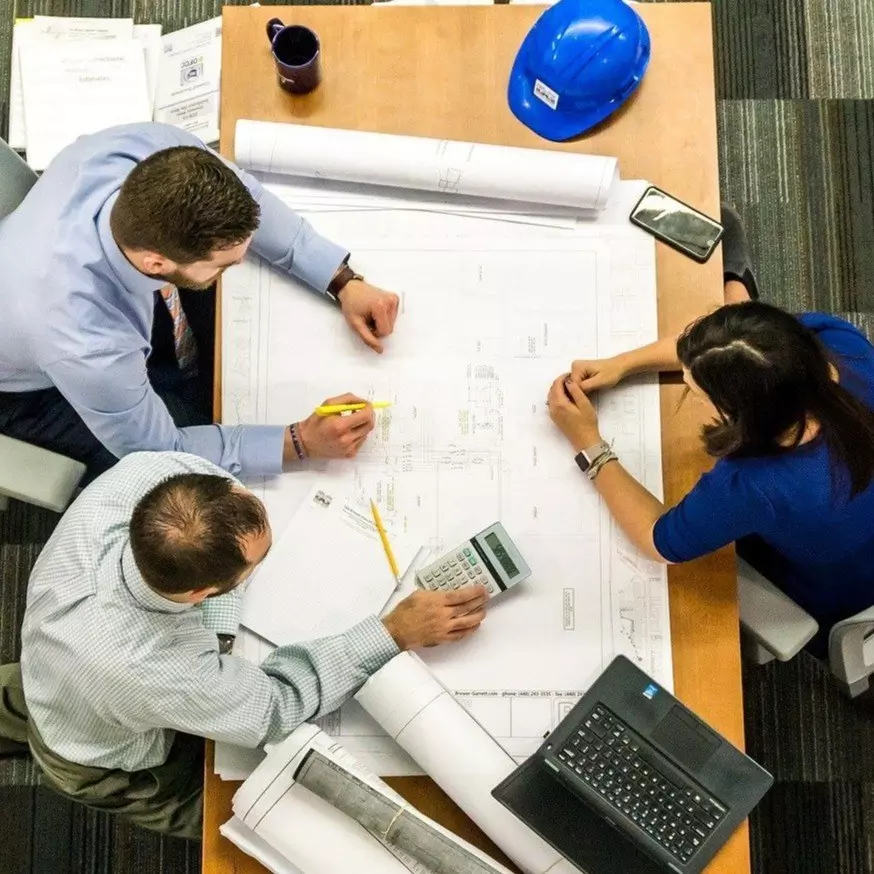What is an architectural blueprint drawing? This article looks at the purpose of an architectural blueprint and show how they are used by architects.
Bob Trimble is a chartered architect registered with RIBA with 30 years experience in the industry. Trimble Architects work throughout Hounslow, Twickenham, Richmond, Kingston Upon Thames, Teddington and the surrounding areas of London.
What's The Difference Between A Plan And A Blueprint?
There are a few, often, unnoticeable differences between blueprints and plans in the architecture world. However, professional designers in the industry often use these words interchangeably.
A plan or a blueprint means relatively the same thing; they refer to a technical drawing to scale, displaying a specific room or a complete house. So, which is most common and which phrase do you need to use when working in this field? The answer is, they are the same, and you may use whatever you are most comfortable with.
Throughout your career or endeavours in the industry, you'll hear numerous contractors and designers in different cities and regions use various other expressions when getting a building permit. We would suggest referring to the technical drawing as whatever the others in your city, town or area call them, whether plan or blueprint.

When planning the remodelling of a building or property, these collective elements may not be required.
For example, you might not need a formal blueprint for a simplistic remodelling project, and it is then your or your architect's responsibility to check this against the regulations.
You can do so by contacting your local building and inspections office to find out if you require a complete set of blueprints/plans or other necessary drawings, comments or details that express all your related buildings desires thoroughly and practically.
You must ensure that all blueprint architecture examples are from the early 20th century if they are remodelling a site, and they must be as up to date as possible.
In addition to any construction drawings, your plans or blueprints will provide the contractor with all the specific information on your project and exactly how the architects believe builders and contractors should complete the job to ensure everything complies with health and safety regulations.
What is a blueprint?
Many designers and contractors who have experienced plenty of building construction are most likely to understand precisely what a blueprint is. The blueprint is the most standard communication technique between workers and designers, and it is most commonly used to copy any construction and complex large architectural drawings.
In previous years, many architectural blueprints have incorporated white lines on top of blue backgrounds; however, designers have opted for blue lines on white backgrounds in more recent years. Either option allows the number of lines and features to stand out much more in a way that is more accessible to those constructing the clients building project.
Now we can take a deep dive into the purpose of architectural blueprints and everything you need to know about them before planning or making notes about other areas of your dream home or new build property.
Blueprints are incredibly technical and far more detailed plans for your constructions or remodel project. The commonly used name "blueprint," in terms of architectural structure, derives from the coating and materials that architects use to produce all the building plans.
Such is due to the results in the printing process when lines and design ideas were, as mentioned previously, white with a blue background. In more recent years, the printing process has caused the blueprints to emit a strong scent of ammonia.
Modern-day designers now have the ease and luxury of using laser and inkjet printing technologies. These devices allow architects to recreate their client's visions in these drawings without using old blueprint printing processes for the modern era.
In this way, the blueprint name is now a hold-over from a time past and whilst the name is still thrown around the industry, the methods to create architectural drawings is now far more advanced.
However, the traditional techniques are still favoured by many architect services and designers in the industry.

Blueprints are typically drawn to scale in either 24 by 35 or 18 by 24. Frequently, blueprints will come in a complete set, including drawings of the floor plan, plans displaying the elevation of each side of the structure, and a foundation or basement plan.
It will also include bearing walls and footings, a full electrical layout plan, a framing plan, cross-section displays of all structural elements, all plumbing and mechanical systems drawings and finally, a roof plan and a general plot plan. Many include all necessary details of a house or property right down to all doors and windows placements.
Why is a blueprint blue?
When making these blueprints, the printing process develops a distinct colour, aligning it with its name. The process begins with creating a drawing of the vision onto a translucent tracing paper page.
That drawing is then placed on paper coated with potassium ferrocyanide and ammonium iron citrate, forming the blueprinting paper. The mix of these chemicals comes from an aqueous solution, and once the drawing has been accurately placed on it, it is left out to dry.
When these two papers are put together against the exposure of bright lights, the chemicals experience a reaction that forms compounds, and these compounds are known as blue ferric ferrocyanide. Sometimes, it may also be referred to as Prussian blue.

Aspects that do not turn blue are covered areas; these are where light has been blocked and not exposed to sunlight to document the lines of the original drawing.
Therefore, it leaves negative white space against the dark blue background, these lines of which help display your plans most clearly.
Professionals, for some time, considered the blueprinting process to be less expensive and less time-consuming than simple hand tracing techniques.
Even after many years passed and the induction of copier machines and carbon copying, professionals and architects in the built environment continues to use the blueprinting techniques and method for many of their large scale engineering project drawings.
What is the purpose of an architectural blueprint?
The most critical and shared purpose of the architectural blueprint is to create reproductions of large-scale drawings. The reason why many use this method is due to its complete inexpensiveness. Compared to the tremendous costs of copying machines, especially large-format pictures, the blueprinting process is seen amongst many as a fantastic bargain.
Blueprints, in past years, were entirely less time-consuming, which is why many professionals in the industry prefer them for many years. They are easily recognisable due to their white lines atop a dark blue background and are straightforward for creating accurate original reproductions of drawings.
Do architects still use blueprints?
There have been numerous processes and technologies invented for modern-day use to take the place of blueprinting. It began in the 1940s; this was when the original methods of blueprinting began to be replaced with blue lines on a white sheet of paper as opposed to vice versa.
Such a process has since been replicated in more current eras with the latest computer-aided printing technology.
Nowadays, it is no longer necessary for architects or construction engineers to spend time printing their drawings onto blueprint paper, as nowadays, designers can do these drawings and display them digitally. You can now quickly transfer these digital images between builders, architects, and other professionals in the construction environment and industry.
The blueprinting process is often termed obsolete, as we have reached an age where it has been successfully replaced with large-format xerographic photocopiers.
Are you planning to hire an architect in Twickenham or the surrounding areas of London? Follow the link below to find out more about project management consultancy in London.
Architects Near Me
Are you looking for architects near me? If you are looking for RIBA local architect services in Twickenham and the surrounding areas. Trimble Architects works with clients throughout London and the surrounding areas including:
Bob Trimble is a chartered architect registered with RIBA. Bob Trimble has 30 years of experience working with residential and commercial property projects. For 4 years, Bob Trimble has worked from his housing association and private architectural practice for clients throughout Hounslow, Twickenham, Richmond, Kingston Upon Thames, Teddington and the surrounding areas of London.

